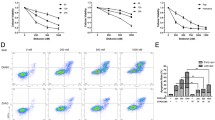Abstract
STAT3 pathway plays an important role in the growth of diffuse large B-cell lymphoma (DLBCL) cells. Here we investigated the antitumor activity of Quercetin, a flavonoid compound, in combination with rituximab in DLBCL cell lines in vitro. We found that Quercetin synergistically enhanced rituximab-induced growth inhibition and apoptosis in DLBCL cell lines. Moreover, we found Quercetin exerted inhibitory activity against STAT3 pathway and downregulated the expression of survival genes. These results suggest that combining the Quercetin with rituximab may present an attractive and potentially effective way for the treatment of DLBCL.





Similar content being viewed by others
References
Pileri, S. A. (1997). A clinical evaluation of the International Lymphoma Study Group classification of non-Hodgkin’s lymphoma. The Non-Hodgkin’s Lymphoma Classification Project. Blood, 89(11), 3909–3918.
Cheson, B. D., & Leonard, J. P. (2008). Monoclonal antibody therapy for B-cell non-Hodgkin’s lymphoma. New England Journal of Medicine, 359(6), 613–626.
Coiffier, B., et al. (2002). CHOP chemotherapy plus rituximab compared with CHOP alone in elderly patients with diffuse large-B-cell lymphoma. New England Journal of Medicine, 346(4), 235–242.
Hiddemann, W., et al. (2005). Frontline therapy with rituximab added to the combination of cyclophosphamide, doxorubicin, vincristine, and prednisone (CHOP) significantly improves the outcome for patients with advanced-stage follicular lymphoma compared with therapy with CHOP alone: results of a prospective randomized study of the German Low-Grade Lymphoma Study Group. Blood, 106(12), 3725–3732.
Pfreundschuh, M., et al. (2006). CHOP-like chemotherapy plus rituximab versus CHOP-like chemotherapy alone in young patients with good-prognosis diffuse large-B-cell lymphoma: A randomised controlled trial by the MabThera International Trial (MInT) Group. Lancet Oncology, 7(5), 379–391.
Gibellini, L., et al. (2011). Quercetin and cancer chemoprevention. Evidence-based Complementary and Alternative Medicine 2011, 591356.
Harwood, M., et al. (2007). A critical review of the data related to the safety of quercetin and lack of evidence of in vivo toxicity, including lack of genotoxic/carcinogenic properties. Food and Chemical Toxicology, 45(11), 2179–2205.
Chou, T. C., & Talalay, P. (1984). Quantitative analysis of dose-effect relationships: The combined effects of multiple drugs or enzyme inhibitors. Advances in Enzyme Regulation, 22, 27–55.
Vega, M. I., et al. (2004). Rituximab inhibits p38 MAPK activity in 2F7 B NHL and decreases IL-10 transcription: Pivotal role of p38 MAPK in drug resistance. Oncogene, 23(20), 3530–3540.
Suzuki, E., Umezawa, K., & Bonavida, B. (2007). Rituximab inhibits the constitutively activated PI3K-Akt pathway in B-NHL cell lines: Involvement in chemosensitization to drug-induced apoptosis. Oncogene, 26(42), 6184–6193.
Mendoza, E. E., & Burd, R. (2011). Quercetin as a systemic chemopreventive agent: Structural and functional mechanisms. Mini Reviews in Medicinal Chemistry, 11(14), 1216–1221.
Russo, M., et al. (2012). The flavonoid quercetin in disease prevention and therapy: Facts and fancies. Biochemical Pharmacology, 83(1), 6–15.
Middleton, E., Jr., Kandaswami, C., & Theoharides, T. C. (2000). The effects of plant flavonoids on mammalian cells: Implications for inflammation, heart disease, and cancer. Pharmacological Reviews, 52(4), 673–751.
Jacquemin, G., et al. (2012). Quercetin-mediated Mcl-1 and survivin downregulation restores TRAIL-induced apoptosis in non-Hodgkin’s lymphoma B cells. Haematologica, 97(1), 38–46.
Darnell, J. E., Jr. (1997). STATs and gene regulation. Science, 277(5332), 1630–1635.
Stark, G. R., et al. (1998). How cells respond to interferons. Annual Review of Biochemistry, 67, 227–264.
Yu, H., & Jove, R. (2004). The STATs of cancer—new molecular targets come of age. Nature Reviews Cancer, 4(2), 97–105.
Yu, H., Pardoll, D., & Jove, R. (2009). STATs in cancer inflammation and immunity: A leading role for STAT3. Nature Reviews Cancer, 9(11), 798–809.
Ding, B. B., et al. (2008). Constitutively activated STAT3 promotes cell proliferation and survival in the activated B-cell subtype of diffuse large B-cell lymphomas. Blood, 111(3), 1515–1523.
Scuto, A., et al. (2011). STAT3 inhibition is a therapeutic strategy for ABC-like diffuse large B-cell lymphoma. Cancer Research, 71(9), 3182–3188.
Muthian, G., & Bright, J. J. (2004). Quercetin, a flavonoid phytoestrogen, ameliorates experimental allergic encephalomyelitis by blocking IL-12 signaling through JAK-STAT pathway in T lymphocyte. Journal of Clinical Immunology, 24(5), 542–552.
Chen, Y. W., et al. (2013). Cardioprotective effects of quercetin in cardiomyocyte under ischemia/reperfusion injury. Evidence-based Complementary and Alternative Medicine, 2013, 364519.
Kleemann, R., et al. (2011). Anti-inflammatory, anti-proliferative and anti-atherosclerotic effects of quercetin in human in vitro and in vivo models. Atherosclerosis, 218(1), 44–52.
Choi, J. S., et al. (2009). Blockade of oxidized LDL-triggered endothelial apoptosis by quercetin and rutin through differential signaling pathways involving JAK2. Journal of Agriculture and Food Chemistry, 57(5), 2079–2086.
Li, J. M., et al. (2013). Quercetin preserves beta-cell mass and function in fructose-induced hyperinsulinemia through modulating pancreatic Akt/Foxo1 activation. Evidence-based Complementary and Alternative Medicine, 2013, 303902.
Michaud-Levesque, J., Bousquet-Gagnon, N., & Beliveau, R. (2012). Quercetin abrogates IL-6/STAT3 signaling and inhibits glioblastoma cell line growth and migration. Experimental Cell Research, 318(8), 925–935.
Qin, Y., et al. (2012). Quercetin affects leptin and its receptor in human gastric cancer MGC-803 cells and JAK-STAT pathway. Xi Bao Yu Fen Zi Mian Yi Xue Za Zhi, 28(1), 12–16.
Cao, H. H., et al. (2014). Quercetin exerts anti-melanoma activities and inhibits STAT3 signaling. Biochemical Pharmacology, 87(3), 424–434.
Niu, G., et al. (2002). Roles of activated Src and Stat3 signaling in melanoma tumor cell growth. Oncogene, 21(46), 7001–7010.
Aoki, Y., Feldman, G. M., & Tosato, G. (2003). Inhibition of STAT3 signaling induces apoptosis and decreases survivin expression in primary effusion lymphoma. Blood, 101(4), 1535–1542.
Ferry, D. R., et al. (1996). Phase I clinical trial of the flavonoid quercetin: Pharmacokinetics and evidence for in vivo tyrosine kinase inhibition. Clinical Cancer Research, 2(4), 659–668.
Author information
Authors and Affiliations
Corresponding author
Additional information
Xin Li and Xinhua Wang contributed equally to this work.
Rights and permissions
About this article
Cite this article
Li, X., Wang, X., Zhang, M. et al. Quercetin Potentiates the Antitumor Activity of Rituximab in Diffuse Large B-Cell Lymphoma by Inhibiting STAT3 Pathway. Cell Biochem Biophys 70, 1357–1362 (2014). https://doi.org/10.1007/s12013-014-0064-8
Published:
Issue Date:
DOI: https://doi.org/10.1007/s12013-014-0064-8




